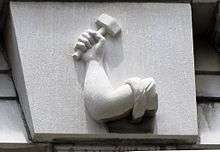Arm and hammer (symbol)

The arm and hammer is a symbol consisting of a muscular arm holding a hammer. Used in ancient times as a symbol of the god Vulcan, it came to be known as a symbol of industry, for example blacksmithing and gold-beating. It has been used a symbol by many different kinds of organizations, including banks, local government, Freemasons, and socialist political parties.
It has been used in heraldry, appearing in the Coat of arms of Birmingham and Seal of Wisconsin.
The similarity to the name of the industrialist Armand Hammer is not a coincidence: he was named after the symbol, as his father Julius was a supporter of socialist causes, including the Socialist Labor Party of America, with its arm-and-hammer logo.[1]
The Arm & Hammer brand is a registered trademark of Church & Dwight, an American manufacturer of household products. According to the company, the logo originally represented Vulcan.[2] Armand Hammer made an offer to outright purchase this company having this brand with the similarity to his name, and while this offer was refused, he eventually acquired enough stock to have a controlling interest and join the board of directors. He remained an owner until his death in 1990.[3]
An arm-and-hammer sign can be seen in Manette Street, Soho, symbolizing the trade of gold-beating carried on there in the nineteenth century. It is referred to by Charles Dickens in A Tale of Two Cities.[4] As of 2016, the sign there is a replica, with the original being held in the Dickens Museum.[5]
References
- ↑ "1990: Armand Hammer, Who Was Named for the Symbol of Socialism, Dies - This Day in Jewish History - Haaretz". www.haaretz.com. Retrieved 2016-09-10.
- ↑ "History of Product Names & Trademarks: Arm & Hammer Baking Soda". www.trivia-library.com. Retrieved 2016-09-10.
- ↑ Did tycoon Armand Hammer have anything to do with Arm & Hammer baking soda?
- ↑ "In a building at the back, attainable by a courtyard where a plane tree rustled its green leaves, church organs claimed to be made, and likewise gold to be beaten by some mysterious giant who had a golden arm starting out of the wall... as if he had beaten himself precious." – A Tale of Two Cities, Charles Dickens
- ↑ Hibbert, Christopher; Weinreb, Ben (2010). The London Encyclopaedia (3rd Edition). Macmillan. p. 524. ISBN 9781405049252.
External links
-
 Media related to Arms with hammer in heraldry at Wikimedia Commons
Media related to Arms with hammer in heraldry at Wikimedia Commons -
 Media related to Hammers in heraldry at Wikimedia Commons
Media related to Hammers in heraldry at Wikimedia Commons